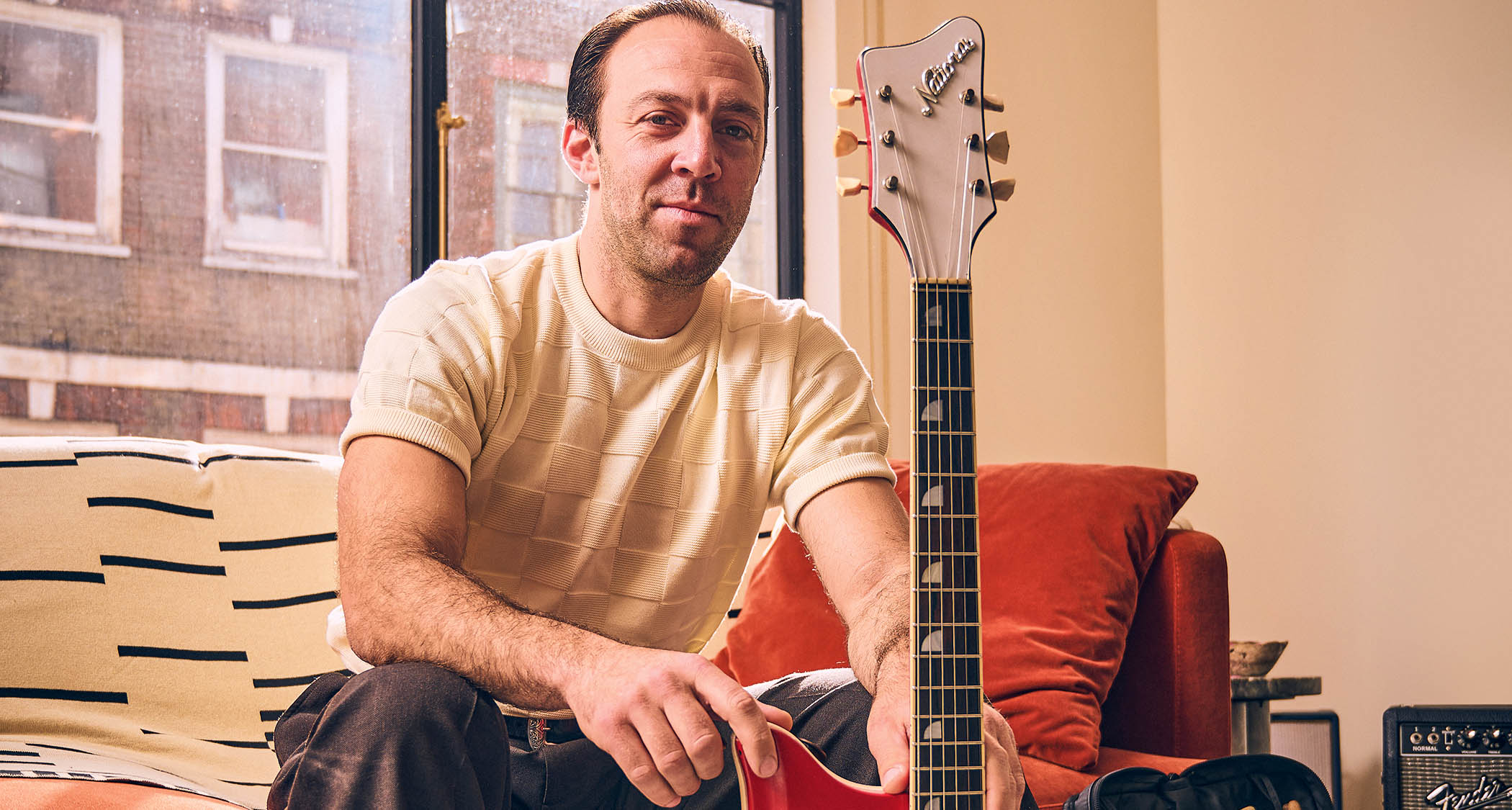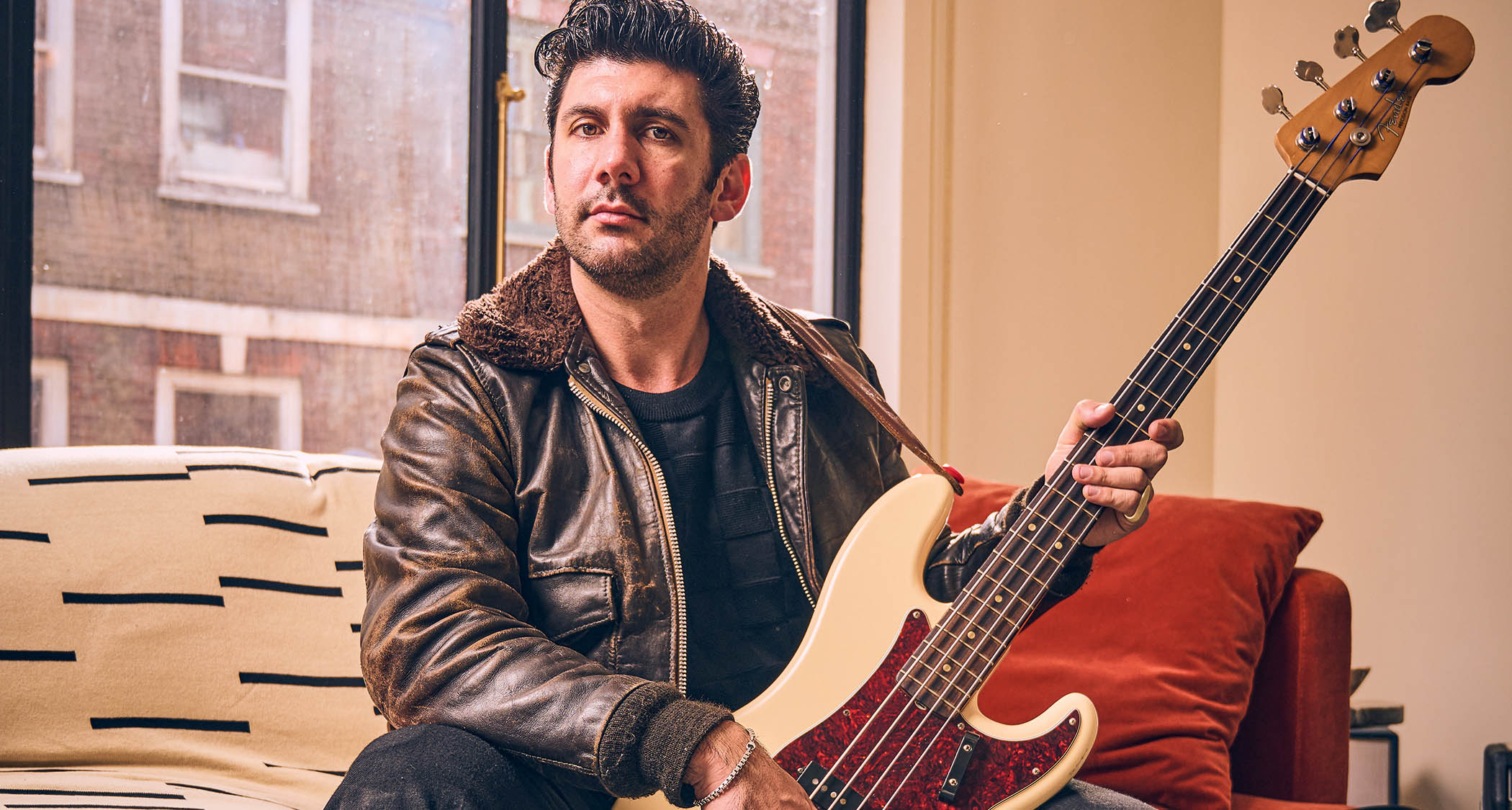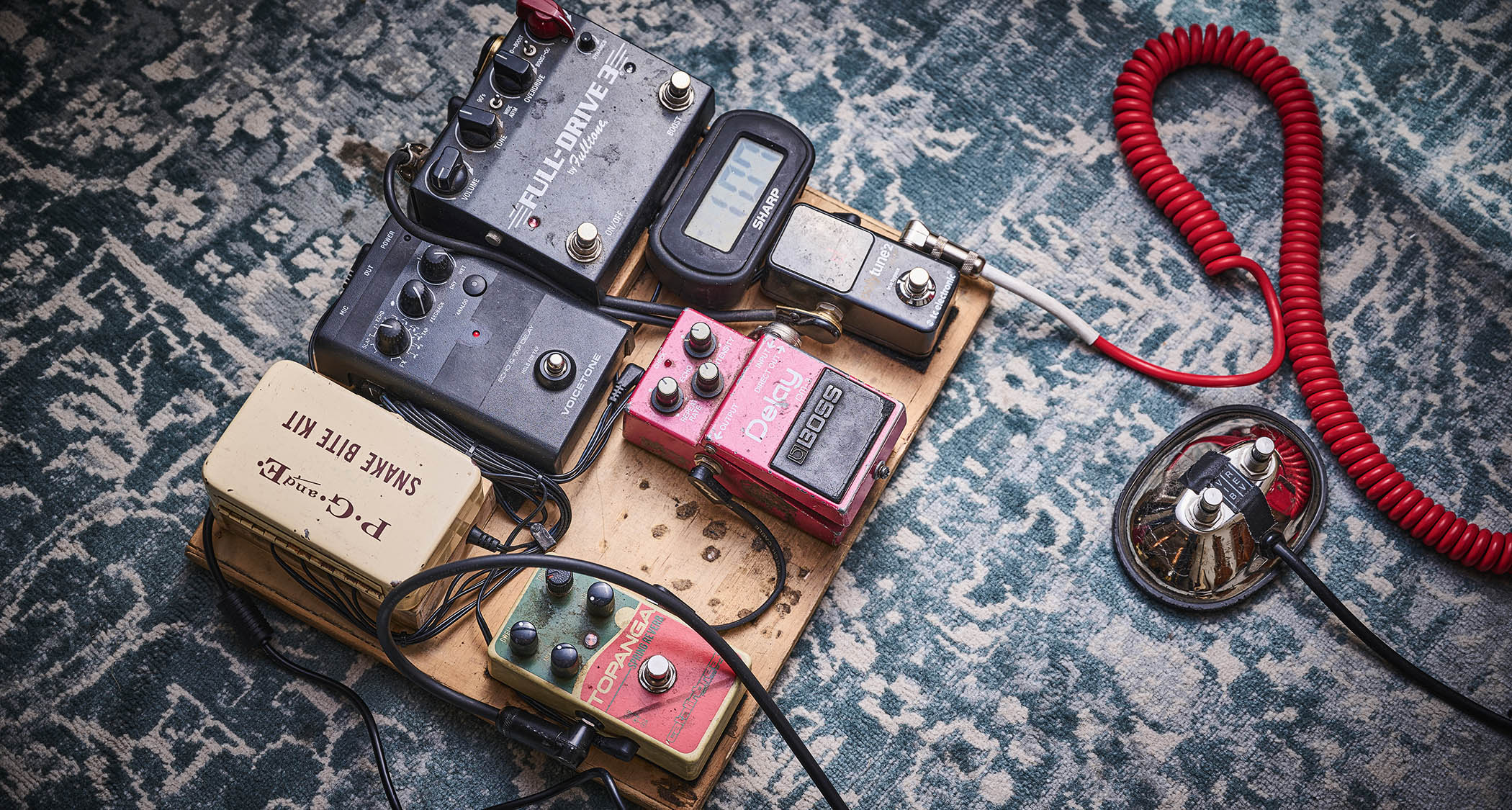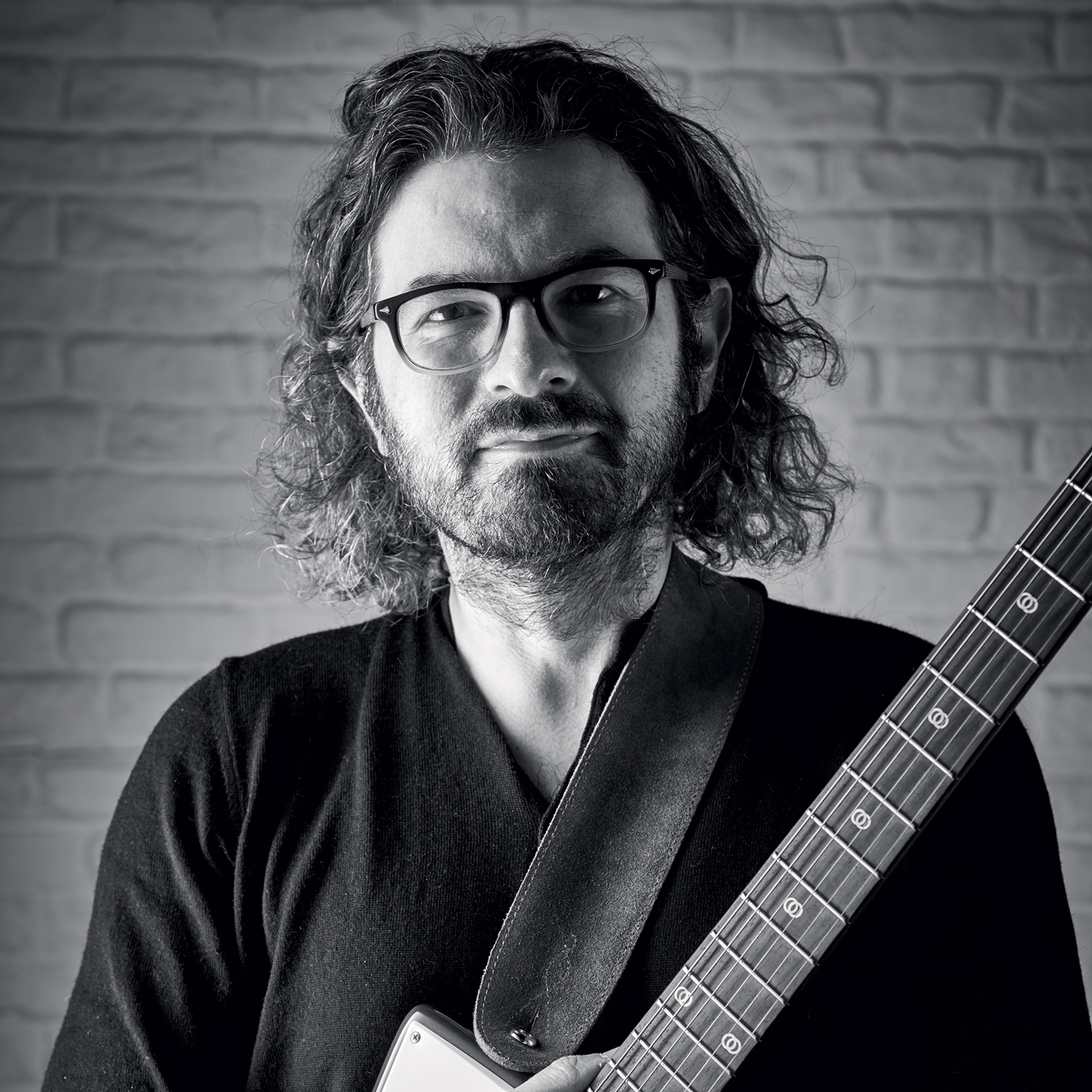“People hear surf guitar in our music, but I think that comes more from the fact Dick Dale was Greek – so Misirlou was a Greek tune”: Introducing LA LOM, the LA trio turning fiberglass guitars and psychedelia into a dance party of guitar instrumentals
This trio fuse the rhythms of Havana, Medellín and Lima with ’60s surf rock (even if that isn’t their intention). Guitarist Zac Sokolow, bassist Jake Faulkner and drummer Nicholas Baker tell us how it all comes together
![LA LOM [L-R] Nicholas Baker on percussion, Zac Sokolow on his fiberglass guitar, and Jake Faulkner plays a custard-yellow double bass](https://cdn.mos.cms.futurecdn.net/nxKtr2RYyU72p7yqfZPjP.jpg)
A while ago, growing bored of familiar tunes, we asked British jump blues guitarist Chris Corcoran for his recommendations: “Check out LA LOM,” was his unhesitating reply.
We did so and weren’t disappointed – the band’s music, captured in what looks like ’50s Technicolor on their artfully shot videos – sounds like something you might have heard in a dockside bar in Havana sometime back in the day.
Sultry, percussive and irresistibly melodic, the shimmering, mirage-like sound of guitarist Zac Sokolow, the pulsing bass of Jake Faulkner, and the complex, compulsive rhythms of percussionist Nicholas Baker conjured up a world of chrome bumpers, sweltering heat and vintage dancehalls.
We joined the band as they passed through London on their recent European tour to find out more about the deep roots of their sound.

How did you originally form and come up with such a unique sound?
Nicholas Baker: “I got a gig for us and I needed a band, really, because [a promoter had said] ‘Hey, let’s put a night together.’ So I hit up Jake…”
Jake Faulkner: “Zac and I have been working together since we were teenagers. We were looking for a way to keep it small – a trio at best – and so we needed a melodist. And the best guy I knew was Zac.”
All the latest guitar news, interviews, lessons, reviews, deals and more, direct to your inbox!
Zac Sokolow: “Me and Jake, we’ve been playing a lot of rockabilly and stuff that was leaning towards country music and bluegrass, playing in a lot of different groups together that did that kind of thing, since we were about 16 or 17.
“But when we started playing with Nick, his background is more like Afro‑Cuban percussion and we just started out by finding a repertoire that worked well together.”

“A lot of the first music we played was classic Latin music from the ’30s – mostly Mexican boleros and stuff like that. A lot of Cuban music, too. There was a group called the Lecuona Cuban Boys that we all really liked and we were learning a bunch of their tunes. Actually, the second song we played [on the video accompanying this feature], Ghosts Of Gardena, was inspired by the Lecuona Cuban Boys.
“So we went from playing more background-music type gigs to playing bars and playing in front of people, and playing for dancers – that’s when we started bringing in more cumbia [traditional Colombian dance music] and working out our arrangements of covers and writing – and things took off from there.”
How do you write your material together?
Zac: “I think a lot of the best stuff we play – the original songs – we came up with from playing in front of dancers. We try to keep stuff really spur-of-the-moment, really improvisational when we play. And sometimes I’ll be playing a solo or something that will turn into some little melody that we’ll all remember and we’ll play next time, you know?”
Jake: “Or sometimes live, he’ll find a riff that he likes, and because it’s just the three of us, he can say, ‘Hey, do those chords again.’ We’ve been playing together for so long that on a good night, I can just follow where he wants the melody to go. Actually, Ghosts Of Gardena started like that.”
Zac: “Yeah, I mean, all our songs have melody. They almost have the form of real songs, as opposed to instrumentals. We think in terms of verses, choruses, bridges; even though no-one’s singing, we still think of the form that way. So there will be a few different melodies, and then within that there’s room for me to mess around a little bit. And I’ll take solos or little improvisational breaks in the middle of it.”
The other half of the equation is, of course, the languid Cuban-style percussion that underpins the melody. What rhythmic styles from Cuba are important in LA LOM’s sound?
Nick: “The first one I learned is a rhythm called tumbao, but you can add a lot of it, especially for what we’re doing – but that’s the basic beat. I would say that there’s three beats I take from the most, and that’s tumbao, mozambique and guaguancó.
“Those are three foundational rhythms for a lot of different Afro‑Cuban music. And then, of course, the clave, which holds everything together. So, within all our music, there’s definitely a clave in my head going throughout the whole song.”
The melodies of your music recall the great instrumental guitar hits of the early ’60s – how did you develop such a great feel for melody, Zac?
Zac: “I grew up playing music with my dad – he plays mandolin, banjo and that stuff. So really the banjo was my first instrument, and then I switched over to playing mandolin a lot, too.
“A little bit later, when I was a teenager, I started playing fiddle and learning hundreds of tunes that are just melodies where, you know, it was like an A, B, maybe a C section, and you just play the melody with very little improvisation.”
“So I got really obsessed with little catchy melodies. I think that’s informed everything I play now. I’m definitely not much of a riffer or shredder or guitar solo-y kind of person – I mostly like sticking the melody. These guys have convinced me to stray from the melody every once in a while and solo a little bit [laughs]. But yeah, that’s my background.
“There are also some really great musicians who became mentors to me in LA, where we all are from. There’s this guy Tom Marion, who’s an old Sicilian-American musician from Northern California. I learned a lot of melodies on the mandolin from him, And he learned it all from fishermen who’d come in, and barbers [laughs]. So a lot of the way I play guitar is modelled after the way he plays.”
Jake: “You know, I always think about how people hear surf guitar in our music, but I think that [perception] comes more from the fact Dick Dale was Greek and so Misirlou was a Greek tune. I think [our own approach comes] more from that generation of thinking – of applying accomplished folk playing to the electric guitar – as opposed to taking surf guitar and learning that.”
Zac: “Yeah, I definitely don’t really listen to any surf or care about it very much! But yeah, people often say that [my playing] sounds like surf.”
One huge influence on our music is what they call chicha. It’s like the cumbia that came out of Peru in the late ’60s and it blends a lot of elements
So what are the real influences on your sound on the new record?
Zac: “One huge influence on our music is what they call chicha. It’s like the cumbia that came out of Peru in the late ’60s and it blends a lot of elements – more traditional Peruvian melodies, known as huayno, which they then mix with the cumbia beat from Colombia. Psychedelic American rock ’n’ roll also has a lot of that influence in the chicha sound, too.”
Jake: “Yeah, I think chicha is a really good example of folk melodies coming into rock instruments because huayno is so based in beautiful Andean and Peruvian melodies that when you [translate them to] electric guitar and then you get psychedelic, that’s a whole other world of it.”
The record sounds really natural and organic – how did you record it?
Zac: “We started out by just doing a live session, playing a lot of these songs pretty much the way we had been playing them in bars and stuff, with the three of us, although some of them had two or three other musicians.
“There was Dominique Rodriguez playing the bongos and shaker, and sometimes our friend Cody Farwell playing steel, as well as a really great musician from LA, Joshua Kaufmann, playing piano and some stuff. We just had the five, sometimes six, of us and recorded about 12 songs in a day, right?
“We were sitting on this stuff for a while and then we met up with [producer] Elliot Bergman, and he convinced us to add a lot of interesting sounds over these recordings – to layer more cool sound effects and different tones and organs and different kinds of analogue keyboards and stuff. That really helped shape the sound that we wound up with.”

Jake: “We’d done the basic tracking in a studio called Big Bad Sound in Los Angeles, and we brought Elliot the board mixes and he said, ‘We can do so much more with this. Let’s make an album. These are recordings of you playing at the bar. Let’s take it somewhere else.’ And he did.
“Elliot has a kind of curiosity cabinet of wonderful instruments – everything from bells from all over the world or that he’s made himself, to Fisher-Price organs that found their way onto the record. So getting to play with all of his wonderful analogue toys was really helpful.
“Also Zac, as long as I’ve known him, has gone around the world making recordings of street musicians or bells from churches – I think there’s some English church bells on the record [laughs].”
Zac: “And I think there’s even recordings of coyotes and stuff, too…”
You’ve got a guitar collection to match your vintage sounds, Zac – what were your go-to guitars for the album? And what’s the red guitar you’re playing today?
It’s a fibreglass guitar that’s hollow in the middle and it has all these knobs on it that were supposed to do something at some point, but they don’t work any more
Zac: “So that’s a Val-Pro 82 – 82 is not the year, that’s just the model number. I think it’s from around 1960 to 1962. Val-Pro was made by Valco and I guess Valco was the parent company that had National, Supro and Airline.
“It’s a fibreglass guitar that’s hollow in the middle and it has all these knobs on it that were supposed to do something at some point, but they don’t work any more. So I just have a volume. It had a capacitor that would darken the tone to pretend like you had different pickups – but I short it all out.
“This guitar is pretty dark and muddy-sounding. Usually, when I play through a Twin or Deluxe, which are pretty bright amps, I’ll put the treble all the way up or close to it. That’s kind of what makes the guitar sound right because it’s pretty dark [laughs].”
We’ve seen you play a nice block-inlay Fender Jaguar, too, on some of your videos.
Zac: “Yeah, I sometimes use a Jaguar, I like the tremolo bar on that. And then I play a Kay Style Leader from around the same time, like 1960, and that’s my second favourite guitar.”
With bands such as Khruangbin garnering a mainstream audience, it feels like instrumental music – especially instrumental guitar music – is having a bit of a moment.
Nick: “They’re very talented and [Khruangbin guitarist Mark Speer] is able to evoke emotions just through melody. I think it’s very rare for guitars to do that – but obviously there’s a pretty good one right here, too [laughs].”
Zac: “It’s rewarding to see people so engaged with instrumental music. I think one of the things that we’re bringing, that other groups maybe are less focused on, is sort of a dance concert.
“Whereas a lot of the other instrumental bands bring more of a groove and a vibe and people can move to it – which is fantastic. But because so much of our sound originated in Colombia and chicha stuff, it’s really a dance party [laughs].”
- The Los Angeles League of Musicians is out now via Verve.
- This article first appeared in Guitarist. Subscribe and save.
Jamie Dickson is Editor-in-Chief of Guitarist magazine, Britain's best-selling and longest-running monthly for guitar players. He started his career at the Daily Telegraph in London, where his first assignment was interviewing blue-eyed soul legend Robert Palmer, going on to become a full-time author on music, writing for benchmark references such as 1001 Albums You Must Hear Before You Die and Dorling Kindersley's How To Play Guitar Step By Step. He joined Guitarist in 2011 and since then it has been his privilege to interview everyone from B.B. King to St. Vincent for Guitarist's readers, while sharing insights into scores of historic guitars, from Rory Gallagher's '61 Strat to the first Martin D-28 ever made.
You must confirm your public display name before commenting
Please logout and then login again, you will then be prompted to enter your display name.









